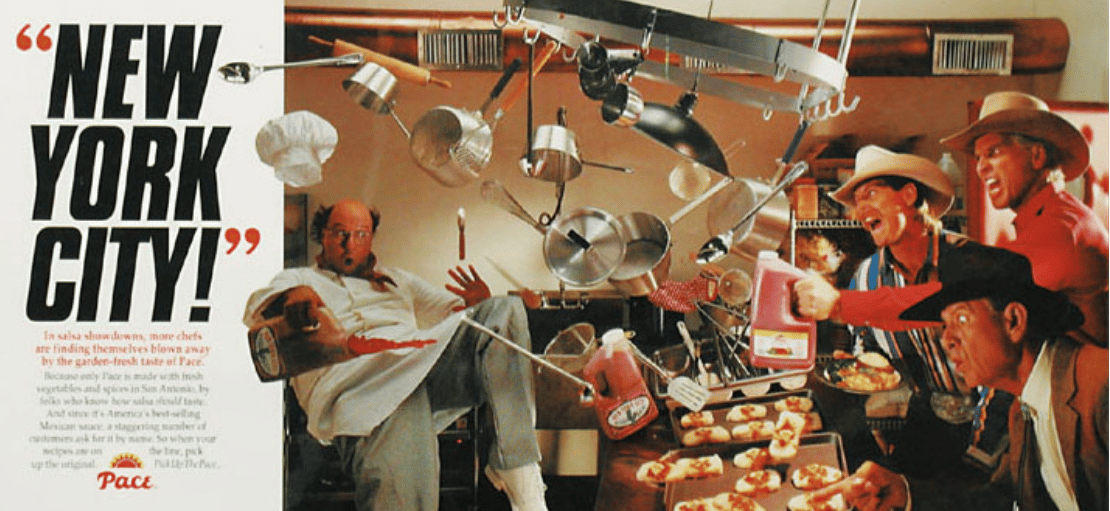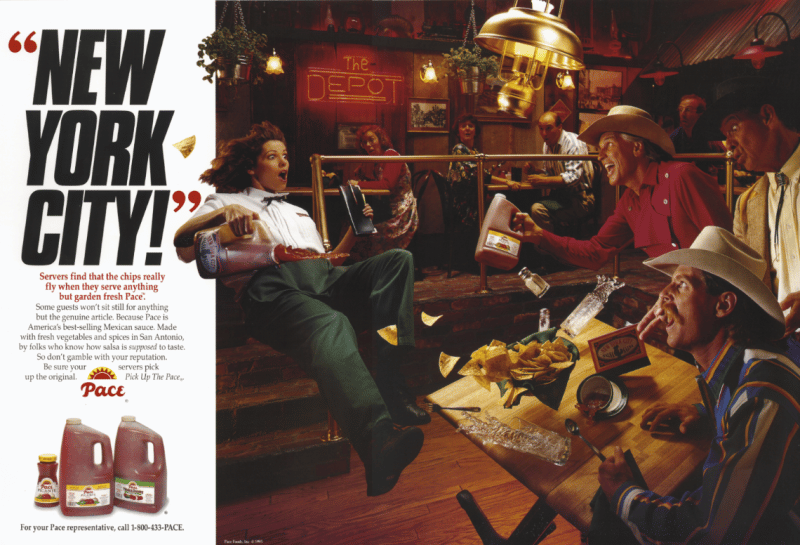
In 1977, the Washington Post believed it necessary to describe salsa for its readers as “a piquant relish used extensively with Mexican foods.”
Yes, salsa was then viewed as that unusual and exotic of a condiment as to require description for those living outside the Southwest.
Yet by 1992 NPR would announce that salsa sales had overtaken ketchup as America’s #1 condiment (by dollars, not units sold).
Just 15 years separated obscurity from national domination.
And right in the middle of that rocket ship ride came Pace Food’s 1980s television ads.
Check out these masterworks of persuasion from Bozell advertising agency:
If you didn’t see these ads when they aired, it’s hard to describe how much a part of pop culture they became.
Just say “NEEEWWW YORK CITY?!?” to a Gen-Xer.
I guarantee they’ll reply with either “Get a rope” or “pick up the Pace.”
…And were these ads ever successful for increasing marketshare amid ever-increasing competition.
For the 1980s brought plenty of competing brands trying to cash-in on Salsa’s meteoric rise in popularity. Heinz, Campbell, and the other big boys of packaged foods all launched their own lines of Salsa in the 80s.
One line, “Montera Salsa,” launched in 1983 with an ad budget of $20 million ($59.5 Million in today’s dollars) — an amount larger than Pace Food’s profits that year.
Fortunately for Pace, which had been making their Picante Sauce since 1947, their “Pick Up the Pace” campaign solidly established their sales leadership over these late-coming, me-too wannabes.
Lots to learn from that!
Here Are the Takeaways
The drama and humor reinforce the sales message
The comic over-reaction of the cowboys when they discover that an “alternative” brand of Picante sauce is made in “NEEEWWW YORK CITY?!?” pounds home three very important sales points:
- Pace is the preferred and expected brand, anything else is 2nd-tier or “no-name.” In fact, the ad won’t make sense unless you accept that baseline premise.
- Authentic picante sauce (aka, Salsa) ought to be made in the Southwest, “where they know what picante sauce is supposed to taste like”
- Corporate, me-too versions of Salsa will never be acceptable to those “in the know” about real Mexican food.
And notice that these little mini-dramas heavily feature what I call Gossip Factors (aka, Fascination Triggers).
If you’ve never heard of them before, the seven triggers are:
-
- Lust,
- Mystique,
- Power,
- Alarm,
- Prestige,
- Vice, and
- Trust
Within each ad you have:
- Lust in the form of desire for Picante.
- Vice when someone attempts to pass of 2nd rate salsa for Pace Picante
- Alarm when diners discover the 2nd-rate salsa comes from NYC
- Prestige — or loss thereof — upon this discovery
- Trust in Pace to provide authentic, high quality Picante
TV Campaigns Benefit from Episodic Structure
Notice how each ad from this campaign has the exact same structure?
And yet each ad is an interesting variation on the theme?
That’s first-rate episodic structure for a Television Ad.
This works exactly the same way that “Leggo My Eggo” works. Or Mr. Whipple.
Or, for print advertising, how Absolut Vodka’s legendary campaign worked.
This kind of structure allows for enough repetition to cement the right associations into the minds of the audience, with enough variation to keep that same audience tuned-in and interested.
Indeed, once the pattern has been established — ritualized — the ability to play with audience expectations works magic.
You make a pattern in order to break a pattern.
And once the pattern has been set, you can compress the entire skit down to its most famous line and people will mentally “fill in” the rest, as these print ads demonstrate:

That’s why Pace is able to basically run a spin-off of this same campaign today:
Brandable Chunks & Earworms Work Magic
If you didn’t catch it by watching the ads, here are the Brandable Chunks for that campaign:
-
- “More Picante Sauce.” Suggesting that Pace people love Pace & go through entire bottles at a decent clip
- “But this ain’t Pace!” Suggesting that people notice and care about the brand of salsa you serve.
- “Pace is made with fresh vegetables and spices by folks in San Antonio who know what Picante sauce should taste like.” Here’s the explicit messaging they’re trying to stick in your head. Note that even if no one remembers this part, they’re subconscious is still soaking it in at every viewing.
- This [other] stuff’s made in New York City! Authentic salsa can’t be made outside of the Southwest.
- NEEEWWW YORK CITY?!? How dare you serve us this slop!
Brandable Chunks allow for exactly the same thing as episodic structure — repetition with variety.
But it’s no accident that the most memorable of the Chunks happens to be the infectious earworm mentioned at the start of this post:
“NEEEWWW YORK CITY?!?”
We are an inherently musical species. Jingles, sound effects, or just interestingly pronounced phrases stick in our brains with amazing power and longevity.
For example, recall these other musically or unusually pronounced advertising phrases:
-
- Rich Corinthian Leather
- They’re Grrreat!
- Time to make the donuts
- Hot Pockets!
- Tastes Great — Less Filling!
What About Your Advertising?
Does the drama and humor in your ad serve to reinforce your message?
If you’re using storytelling in your ads, do you have a repeatable, episodic structure?
Does your campaign make use or Brandable Chunks?
Do you have an earwormy, infectious jingle, slogan, tagline, or sound effect?
If so, keep doing what you’re doing!
If not, your advertising could and should be taken to the next level. Why wait?
P.S. Here’s a bonus lesson: these Pace ads also tapped into the power of Comparative Advertising. They weren’t afraid to call out their competition for being inauthentic, johnny-come-lately, wannabes.
- Getting a Foot in the Door — Of Perception - November 27, 2025
- What Digital Superstars Know About Offline Advertising - November 17, 2025
- Unmistakable: A Tale of Two Boots and Branding Done Right - November 8, 2025
